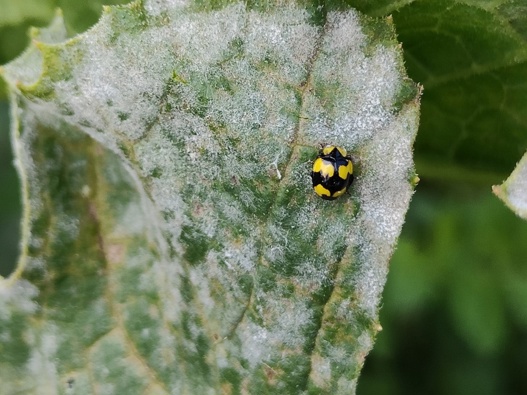Autumn is near and the hot days have certainly increased life in the garden.
Flowers are still banking on pollinators to do their job; they are numerous right now: flies, hover flies, beetles, thrips and mites; of course our native bees are still around as well.
But the invertebrates that cause troubles in the garden and vegetable plots are also on the peak of their numbers; after all they, too, had a warm breeding season and many many offspring.
The greenhouse thrips is one of those critters that loves to feed on the leaves of vegetables and ornamentals: beans, apples, Rhododendrons, Azalea, lilly-pilly, the list is endless.
Best way to identify them is by distinct silvering of the leaves (especially the upper side) with a smattering of brown, often sticky poos on the underside. The plant will usually show the symptoms of severe stress, which makes sense as the photosynthesis is hampered: Thrips suck the cells dry (causing that silvering) and deposit the poo on the underside of the leaves.
The insects look like miniature crocodiles under the microscope.
Frequent neem oil sprays reduce their numbers; Mavrik and a range of other insecticides seem to do the job as well. Do the control now, before too many eggs and juveniles commence their overwintering phase!
Last week we mentioned powdery mildew and that grey, mouldy fungus on plants. Regular sprays (fungicides) were suggested as a suppressing control. But the yellow-and-black ladybirds that live on the infected plants need some control as well!
Contrary to what most gardeners think (that ladybirds are “beneficial” as consumers of pest insects), these Ozzie chappies are Gardeners! They literally spread the spores of mildew round on the leaves, creating the fungal gardens on which they thrive – they literally eat “mushrooms”!
If your apple crop was destroyed by codling moth (Madex 2 or Madex 3 is the preventative spray to use after flowering!!!) the apples will fall on the ground with heaps of caterpillars coming out of their snackbar and looking for a place to pupate in or near the soil.
My best advice is to remove those apples and put them in the food recycling bin for disposal; (DON’T put them in your compost bin as the pupae (chrysalises) will survive the winter and happily continue the codling moth damage next spring).
LISTEN ABOVE
Take your Radio, Podcasts and Music with you










